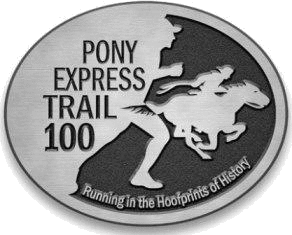
The historic Pony Express trail crosses about three miles from my home. I have a passion for US history and during the winter of 2004-05, I decided that it would be fun to try to run much of the historic trail in western Utah. I had never even driven it before, so running it would be a great new adventure and a good way to run some long distances during the winter months.
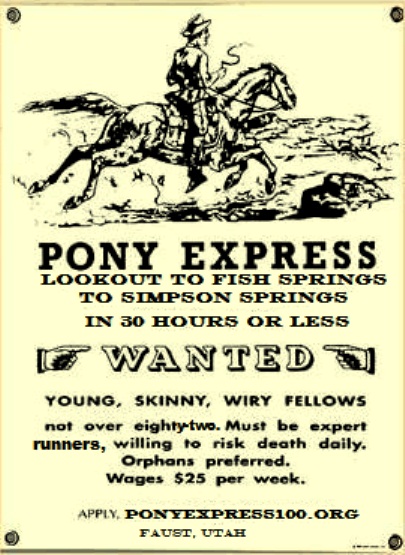
The Pony Express was about fast mail delivery. In our day we send mail around the world in microseconds using the energy it takes to click a key with our finger. In the 19th century the time and effort to take mail across the continent was extraordinary. An overland coach mail service between California and the States began soon after the California gold rush. But the service was inadequate, irregular, and erratic. Harsh weather conditions, long distances, and Indian problems made it difficult to provide regular mail service.
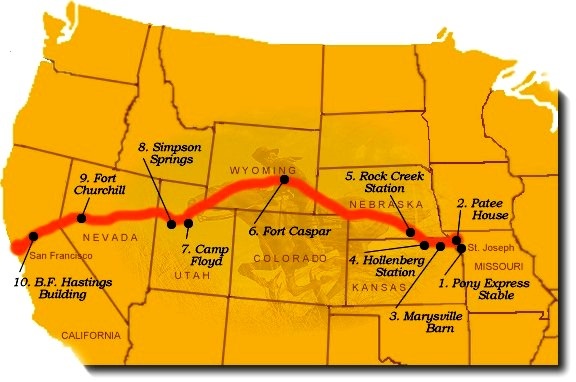
In 1860, the Pony Express company was established to greatly speed up cross-country mail delivery. Mail sent by coaches took at least one month. The Pony Express promised cross-country delivery in only ten days. The system was a relay race. Riders would change about every one hundred miles. The riders would change horses every ten to fifteen miles. Scrawny, athletic riders were hired, “young, good horsemen, accustomed to outdoor life, able to endure severe hardship and fatigue, and fearless.”

My first run on the Pony Express Trail was on December 3, 2004. I left my house on a chilly day and just started running west toward the historic route. I didn’t know what I would see or experience, I just ran. I first ran through housing developments and soon the developments disappeared.

I stopped to look around me. As far as my eye could see, there was nothing man-made to be seen except for the paved road. There was not a structure in sight to all the horizons. The remote feeling was both invigorating and a little fearful. Here I was out in the middle of nowhere, with frigid temperatures, left to my own skills and fitness to stay warm and out of danger, similar to the riders of the past. I ran past three Pony Express station sites and after reaching the 50K mark, called home for a ride.

During the next couple weeks, I continued my run from the points I stopped at, getting help from family to shuttle my car to the finish of each segment. I wrote up my running adventures on the trail was even able to publish several articles in Marathon and Beyond. I wished I could run all the way to the Nevada border but it took too much time driving out to the points to shuttle a car. My friend Brad suggested that instead of shuttling cars, why not run an entire 100 miles on the trail with a car going along to crew me. That sounded like a great idea, but I wouldn’t do anything with that idea for a couple years.

In the meantime, I became a student of directing races. Jim Skaggs had moved to Utah and was experienced putting on an ultra in Ohio. He invited me to participate on a race committee to establish a 25K and 50K on Antelope Island. This was totally new territory for me and I just did my best to try to find ways to help, along with watching and learning. Most runners have no idea about all the organization and costs needed to put on an ultramarathon. I was able to see it first-hand. I realized it was a lot of hard work, a labor of love, but within my capabilities. We spent a full year planning, met with the park officials, tested out the course several times, and eventually opened up registration. The Buffalo Run was first held on March 18, 2006 with about 150 runners. It was a great success and would continue to grow each year into the largest trail race in Utah.
Pony Express Trail 100 – 1st Running
The idea of running the Pony Express in a race format still stirred in my mind. Phil Lowry suggested that we do it as a winter run which would totally connect us with the harsh elements that the pony express riders faced. It was a crazy idea but I set a date for December 29, 2006 and I invited anyone to join us, running either 30, 56, or 100 miles. Eleven runners participated and we arranged for a three crew cars to drive along. We started our crazy run just a few miles from my home at the Pony Express Elementary School in Eagle Mountain, Utah.

It was an exciting morning to see the runners arriving. We soon were off and eventually formed into two groups, a faster and slower group. While running across Cedar Valley, Phil reported that it was 15 degrees. All went very well. At the 30-mile point at Faust, most of the runners finished. Only Phil, Brent Rutledge, Steve Kissell, and I continued. Phil would later drop out at Simpson Springs. I was alone in the lead followed about five miles back by Brent, Steve, and Milada Copeland who joined in to run 100K. During the night it became so cold that I had to wear ski goggles and my handheld bottle would turn into slush in just 20 minutes.

That first year, we had to touch each Pony Express station monument along the way. This meant that we had to visit a monument a mile off the main road, the Dugway Station. After that point, I had marked the course along the actual historic route which required us to bushwhack through the desert. It was a tough thing to do in the middle of the night, in temperatures approaching single digits. Many years later, Steve and Brent still give me a hard time for making the course that difficult.
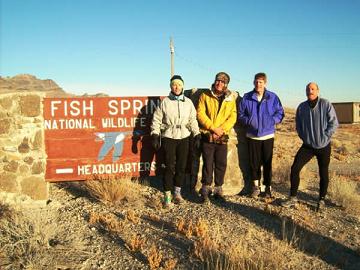
We all pressed on through the very long night and near dawn, I arrived at the 100-mile finish, at Fish Springs National Wildlife Refuge with a time of 25:29, my best 100-mile time up to that point. The couple who managed Fish Springs took me in, fed me, treated me very kindly, and even let me shower while we waited for the others to arrive. They finished in 26:50. As we drove 100 miles back to the start for the next three hours, it amazed me just how far we had run.
2nd Running

Brent Rutledge enjoyed the experience so much that he persuaded me to schedule another Pony Express 100 run just a couple months later on March 2, 2007. This time we pushed the course out 40 miles so we would not run on any pavement, starting at Lookout Pass. If we were successful, we would finish near the Nevada border. We also wanted to try starting in the afternoon, going through the cold night while we were fresher. Jarom Thurston joined us, attempting his fist 100-miler.

Brent ended up having some trouble and dropped at about 30 miles, but Jarom and I pushed on, even through wind chills of zero degrees. Dawn arrived as we ran through the tiny town of Callao, in the middle of nowhere. Jarom had some serious issues at about mile 93 and needed to drop. I continued on and reached the 100-mile mark on top of a mountains range at 23:26, the only one to finish. The roads were nice and soft, but the temperatures were still too cold for running a race out there during that time of year.
3rd Running

The third running was later that year on October 26, 2007. This time the course would start at a Pony Express viewing area near Faust and finished 100 miles out to the west. We started around noon. Leading up to this run, an anonymous trouble-maker tried to do everything possible to stop our run. They contacted the BLM and Tooele County trying to stir up trouble. Their efforts backfired. The BLM, Fish and Game, and Tooele County were all very supportive and interested in our unique run that was getting people out to discover the west desert.
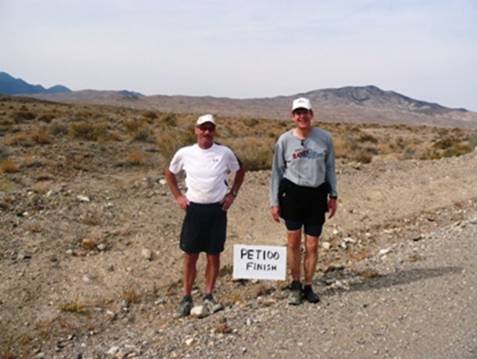
Seven of us started together with several crew cars. The weather was perfect, not too warm during the day and no brutal cold during the night. I had found a good time of year for the race. Runners dropped out along the way for various reasons and at the finish it was me and Brent again. I finished in 24:45, ten minutes after Brent.

The drive back was very tough. I discovered that the roads this time of year were very rough to drive on, not soft like in the spring. Despite slow driving for that 100-mile drive back, we got a flat tire. We changed to a spare, but about 50 miles later the spare went flat too and couldn’t be pumped up. I stopped the van, exhausted, very discouraged and asked, “OK, what do we do now?” Silence. A truck eventually came by and they offered to help. I decided to send the guys into town with the tire and see if they could get it fixed, and then come back to get me. I waited for many hours, exhausted from running 100 miles and stuck in the desert. Paul, my crew guy, came back after dusk and rescued me. The lesson I learned that day was that doing an end-to-end 100-mile race on that road was just too hard on both the runner and the vehicle driving back. The temptation is to drive fast to get home, but in most cases that would result in a flat tire. I decided that the next year would be an out-and-back.
Many race directors conduct a race without testing out the race course. I learned from Jim Skaggs the importance of testing out a course several times before getting serious about making it a formal race. Too many times first-year races turn into disasters. Runners get lost, race markings become vandalized, the distance is off, or various other problems are experienced. I was avoiding all these problems by first introducing this race as a free race. You get what you pay for.
4th Running

October 17, 2008 was the 4th running of the Pony Express Trail 100. This year we again started at Lookout Pass, would head 50 miles along the historic trail to the Blackrock Pony Express Station location and return. That year I made finisher awards and added some signs to make it feel more like a real race.

Seven of us started that year, two which planned on running 50 miles. Three of us finished the 100-miler. That year Matt Ward broke the course record in 23:02 and I finished in 24:26. I wasn’t sure that I had yet found the right course because the final several miles were pretty tough, all uphill. Matt wrote, “That course was deceptively hard….I was WORKED. Those last twelve miles are just a long slow uphill grind that I thought would never end!”
5th Running

In 2009, the race grew up to consist of a bigger field, about 15 starters. That year I introduced two starting times, 6 a.m. and 8 a.m. to give slower runners a head start and a little more time. Also for the first time a 50-mile race.
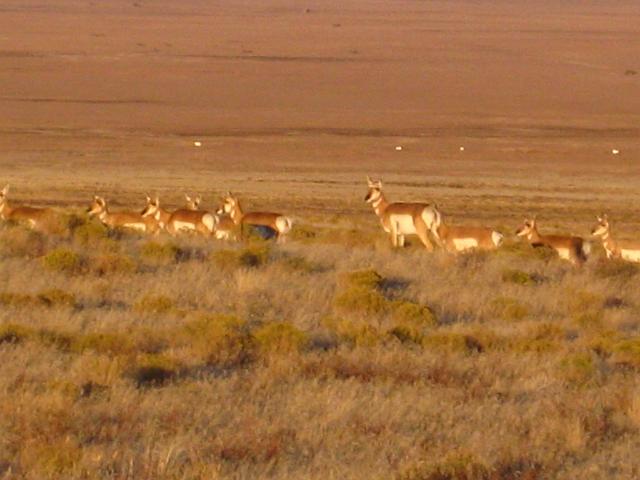
With the early morning start, we encountered for the first time large herds of animals, both antelope and wild horses. Each year after that, they were generally all seen at the same place, between Government Creek (mile 9) and Simpson Springs (mile 16). They were an amazing site to see in the beauty of the morning light.

There is a large fence that extends from the two of Dugway to Simpson Springs. We later learned that someone at Dugway puts out feed for the wild horses and very often they will travel to Simpson Springs along the fence line. Watching them gallop in the desert is a inspiring experience.

That year, Mike Place volunteered to put on a feast at the 50-mile mark where crews and runners could feast on great food and interact. This feast would get bigger and better in each year to follow.

Phil Lowry set the course record for the 50 that year in 9:30 and I lowered the 100-mile record to 22:58. At mile 98 I even stopped for about 20 minutes to conduct a radio interview that was pretty funny. You can listen to the interview here.
Phil Lowry had a great experience and loved the course. During the next week he called and we had a long conversation about the race. He tried to convince me to turn it into a formal race with paid registration. He predicted far more people would come if it was a formal race. I dreaded thinking of all the work needed, but within a few weeks I decided to go for it. I formed a race committee including my backpacking buddies who have been mentioned many times in the other chapters, Brad, David and Carl, and also Craig Lloyd, Phil Lowry, Matt and Anne Watts. They all wanted to help.
There was a lot of work to do. Establish a website, set up registration, design a logo and buckle, get awards, find sponsors, figure out permits, and do some marketing. The hard work had already been done for the past several years – figuring out a course that would work.
6th Running – First formal race year
The 2010 race became real. I changed the course one more time to avoid the grueling uphill finish back to Lookout Pass. The 100-mile course would go out about 58 miles and then come back and finish at Simpson Springs. This would make the course much easier and with the extension of the turnaround point, allow the 100-mile runners to experience the Fish Springs National Wildlife Refuge.
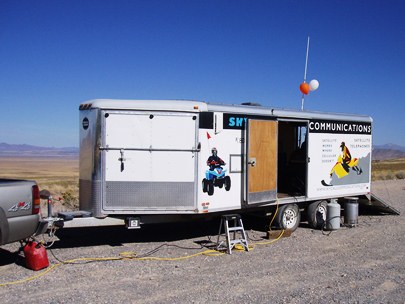
Russ Smith of Skycall and KSL Outdoors radio show became a crucial contributor to the race. Starting in 2010, each year he would bring out his big rig to be an amazing finishing home for the 100-mile runners to recover at Simpson Springs.

That year the field doubled (as Phil predicted), nineteen 100-mile starters and nineteen 50-mile starters. I ran the 100-mile race again. An amazing feature of this course is a long 18-mile straight road section that can really mess with your mind both during the day and the night. During the day it seems that you are never getting closer to the Dugway mountains that you need to go over. In the night you can see the crew vehicles behind you but judging their distance is almost impossible. Sometimes you look back and see what looks like a headlamp chasing you but in reality it is the headlights of a car about ten miles back. A local settler in 1931 wrote about this stretch, “The long, straight road leading down from Simpson to Riverbed stands out on [a moon-lit] night with startling clearness. [The mountains] stand at attention in the weird light. The whole desert seems tense, as if waiting expectantly for something; and one finds himself scanning earnestly the far-off shadows that seem to form and move, and then dissolve again, down the broad white road toward Riverbed.”
That year, during the day, I was in first place among the 100-milers but the warm afternoon slowed me way down. Ed Ettinghausen (the Jester) passed me around mile 60 and by mile 68 it was dark and I was about three miles behind. I had recovered from my problems and had plenty of speed again. At a crewing stop, I strategized with my crew chief, Josh, how we could do a sneak attack on Ed and catch up without him noticing until it was too late. On this course you can usually see your competition coming and it motivates them to run harder. I didn’t want to motivate Ed any more. I had been using a pattern of having my crew car go ahead of me three miles and then stop to wait for me to be crewed. This pattern was a clue to the runner in front how far the runner behind was.
Ed and his crew could see the headlights of my crew car but couldn’t see my flashlight because I started to run by the stars. So, even though I was catching up, Ed wouldn’t notice because I had my crew car keep decreasing the distance driven ahead. After being crewed, I would tell Josh to wait a certain time before driving ahead but never stop ahead of Ed’s crew. It looked like I was still at least 3-4 miles behind. But as I neared Dugway Pass at mile 78.9, Josh reported that I was just a half mile behind Ed. I told him not to go over the pass until I caught up with Ed. At the top of the pass was a checkpoint and buddy Carl was there. He asked, “where is your light?” But then added, “I know what you are doing, sneaking up on him!”
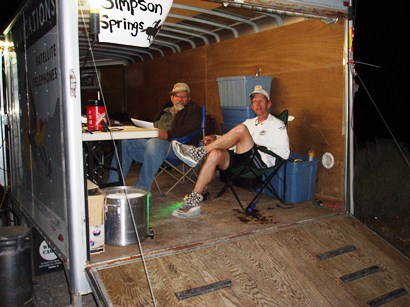
I ran like crazy, descended over the pass in the dark and when I was within about 50 feet of Ed stopped at his crew car, I turned on my bright green light. I’ll never forget the surprised look on Ed’s face. “Davy!” He then pointed to the road ahead and said that 1st place was now all mine. He had been so sure that he had 1st place in the bag. From there, I would use my crew to tell me how far behind me Ed was. I would instruct Josh to wait until Ed passed by, and then drive up to me and report how far behind Ed was. It was a great strategy. I increased my lead up to three miles and finished in first with a new course record of 20:53:02.

It was my 6th Pony Express Trail 100 finish and was the most fun for me. We had twelve 100-mile finishers and had our first female finisher, Adriane Frehner. Fourteen runners finished the 50-mile race, Damian Stoy lowering the course record to 7:37
7th Running
In 2011, the field continued to grow with 20 100-mile starters and 39 50-mile starters. I worked closely with the BLM for the first time that year and they supported our efforts out in the west desert. Jay Aldous crushed the course record and finished to 100 in 15:06:27, a record to stand for years. Seth Wold also lowered the 50-mile course record in 7:17. These guys proved that this was a very fast course.

This was the last year I would run the 100 and also direct the race. With the much bigger field, I discovered how stressful it was to do both. I had to take care of race issues during my run and just couldn’t do both well. I would greatly miss running past most of the field, greeting them along the way. I finished that year in 25:14:35.
8th Running
By 2012, camping out at the start became a fun feature for the race. Many runners and their crews would camp and enjoy getting to know each other at evening campfires. Now that I was taking in fees, I could afford buying items to make the look and feel like a true ultra.

We had a reporter come out from the Salt Lake tribune and he published a front page article about the race that year. The race really grew that year with twenty-seven 100-mile starters and forty-nine 50-mile starters. Young 18-year-old Tyler Bodily lowered the course record for the 50 to 7:15:33.
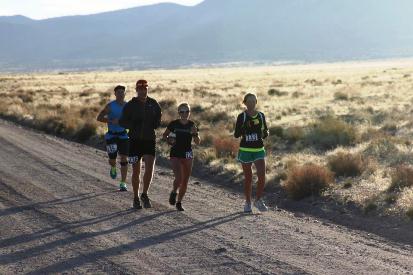
With the race bigger, I established four starting times, assigning times based on predicted pace, with slower runners earlier, and faster later. Around mile 30 must of the runners converge into a large pack covering a few miles on the long straight road to Dugway Pass. Seeing all the crew cars and runners on the road is very amusing to see. A few hunters or tourists drove by and just couldn’t believe their eyes as to what is taking place in the desert.
9th Running
The 2013 race was run under a beautiful full moon. We had thirty 100-mile starters and thirty-six 50-mile starters. Every year so far when we have held the race in October, we have had perfect weather. It was so pleasing to me to watch so many friends run.

My brother Bob, finished his first 100-mile race in 24:26:56. Good friends won the race that year. Matt Van Horn, who I had paced at Wasatch won the 100 in 16:52:55. Kendall Wimmer won the 50 in 7:23:15 and Jen Richards also won the 50 in 7:46:58. There were so many impressive performances. I loved awarding the finisher medals and buckles at the finish lines and watch the emotion and all the hugs among the families and friends.

The feast at Blackrock was amazing. Pablo Riboldi, who has been mentioned many times in this history put on his famous Argentine Barbeque. It is an amazing sight out in the remote desert and it tastes so good. We feed all the crew and runners. It costs a fortune to put on, but well worth it.

We also encouraged decorating crew cars this year and it was funny to watch all the crazy decorated cars out in the desert.

The successes among first-timers on this course is pretty amazing. Also the number of runners who establish personal records is impressive. There were many personal records in 2013. 100-milers, 18 finishers: 15 PRs (including 9 first-timers) 50-milers, 33 finishers: 28 PRs (including 20 first-timers).

But a little discouraging is the high DNF (Did not finish rate) among the 100-milers. Usually at least 40% of the runners do not finish which is a very high rate for 100-mile races. From what I can tell there are two main reasons. The first reason is mental. When things get rough, it is just too easy to quit because your crew car is so close, warm, and comfortable. The second main reason is the flat nature of the course. I’ve watched seasoned mountain 100-milers have a very difficult time with the course because they don’t train enough on the flats. Runners will have muscles cramp up and then choose to quit. But so many are now finishing. By 2013, there have been 79 100-mile finishes and 142 50-mile finishes.
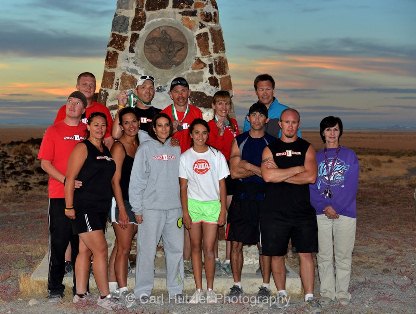
When I went for my solo winter run for the first time on the Pony Express Trail back in 2004, I never dreamed how that little run would grow. In 2013, including runners and crews, I led about 250 people out into the remote desert and from what I could tell, most of them were smiling. Because of the crew format of this race, I’ve heard many stories how families have connected with their ultrarunners for the first time during a race. Usually they just sit and wait, but in this race, they watch and cheer the entire way. Children have connected with dads and moms. Spouses have come away with a better appreciation about what ultramarathons are all about. That is probably the most rewarding part for me, to watch the reactions among the crews.
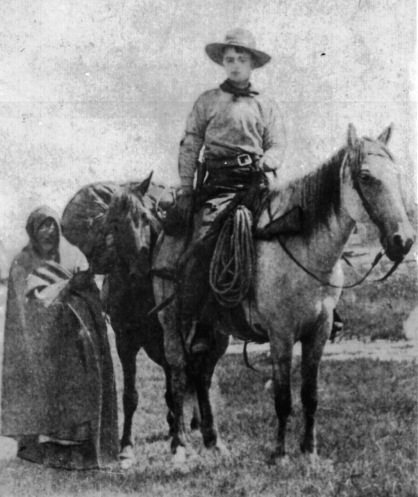
Thanks go to the 19th century Pony Express riders for inspiring this run and demonstrating what endurance can take place, even in the remote desert of western Utah.

